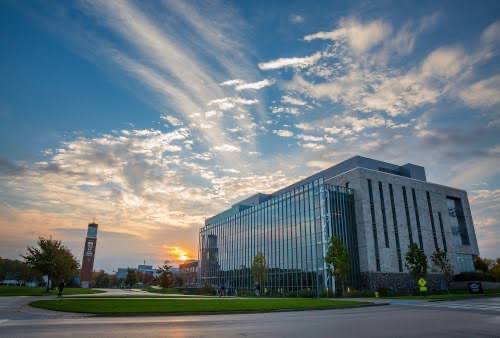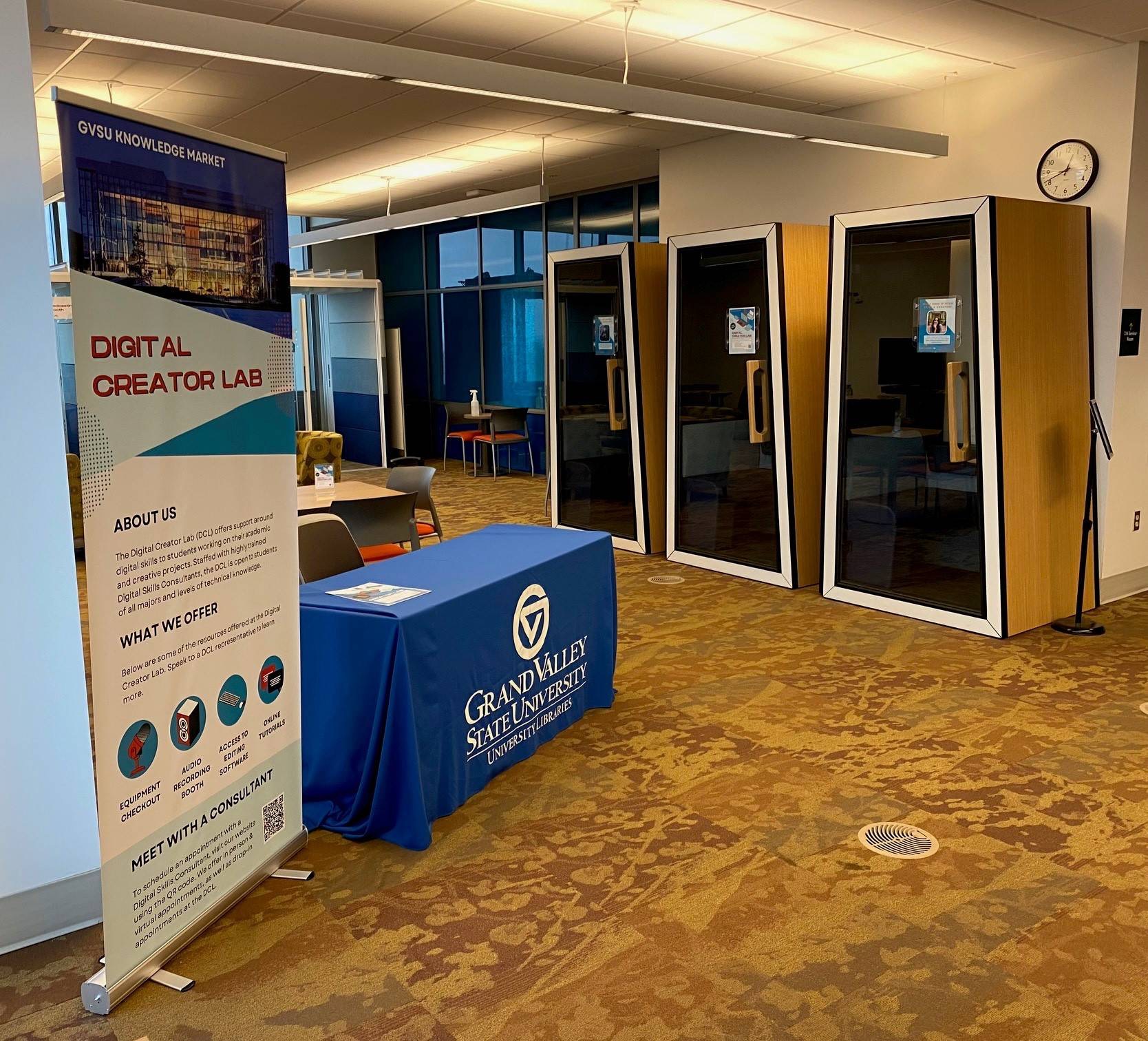News - Off the Shelf
Permanent link for Library Instruction at GVSU Benefits Student Success on April 2, 2024
By: Jillian Beckwell
Have you wondered about library instruction and how it can benefit students? A GVSU Library study found a positive correlation between library-led instruction and student retention. Find out more about what library instruction looks like at GVSU and hear directly from liaison libraries about their role in this process.
POSITIVE CORRELATION BETWEEN LIBRARY INSTRUCTION AND STUDENT RETENTION
A group of current and former GVSU faculty and staff, Mary O’Kelly, Jon Jeffryes, Maya Hobscheid, and Rachael Passarelli completed an eight-year study focusing on the impact of library instruction on student retention. The study demonstrates a positive correlation between library instruction and student re-enrollment, as the percentage of students who experienced library instruction that re-enrolled the subsequent fall semester was higher than the percentage who did not experience library instruction. The percentage throughout the eight years of students who received library instruction and re-enrolled the following fall semester ranged from 73.70%-76.10%, while the percentage of those who did not receive library instruction and re-enroll ranged from 65.7%-71%. Although this study focused on the years 2012-2020, the trend in library instruction and increased re-enrollment rates has now continued for 11 years.
INSTRUCTION AT GVSU LIBRARIES
The GVSU Libraries “equip knowledge seekers to use information to shape their professions, enhance their communities, and create a more equitable society.” To achieve this mission, GVSU’s liaison librarians have included instruction in their list of responsibilities for decades. Instruction introduces students to information literacy skills and allows them to develop them both scholarly and professionally. Information literacy skills are essential to successfully navigate the information landscapes as well as to find and use information ethically and responsibly to contribute to academic, professional, and societal conversations. Typically, liaison librarians teach literacy and research skills such as how to form questions, create keywords, find library resources, and search techniques for library databases and search engines like Google. By working with students in a variety of instruction methods, students are engaged in their university learning and prepared to use their information literacy skills after they graduate.
TYPES OF LIBRARY INSTRUCTION
Liaison librarians meet the needs of students in each discipline through flexibility of instruction methods. Library instruction comes in a multitude of formats: in-person or online, synchronous or asynchronous, through class lectures, research consultations, videos, tutorials, and more. Liaisons prepare in-person and online lectures on information literacy for classes. They work one on one with students during research consultations, advancing student learning and empowering students to acquire the skills necessary for independent research. They also create accessible online learning materials such as instructional videos or tutorials for students to use at point of need. This variety of library instruction methods gives students the opportunity to experience library instruction no matter their discipline, year of study, or location.
Liaison librarians frequently work with first year writing (FYW) students. Since the 1970s, librarians have collaborated with the First Year Writing Program to introduce students to information literacy at the beginning of their undergraduate career. Anna White, a liaison librarian, works particularly with FYW and health sciences students. She compares her different instruction styles with the various students she works with to swimming in a pool. She explains that working with FYW students is a lot like open swim, as students get to “try anything, have a good time, splash around, see what works, see what feels good”. Working with health science students, however, is like competitive lane swimming, as the focus of these students is like “you’re going in one direction and you have to get really good at doing this one thing”. Anna changes her instruction style to meet the needs of her students and aids students in their information literacy journey.
COLLABORATIONS IN LIBRARY INSTRUCTION
Liaison libraries often collaborate with the Knowledge Market (KM), a group of highly trained peer-consultants that are available to support a variety of skills: speech, writing, digital, and research. Consultants often direct students to liaison librarians for more difficult ideas or for another perspective for brainstorming. This service can connect students with liaison librarians when they are too intimidated to do so by themselves. The Resource Market, a part of the online services provided by the KM, is a searchable database of resources for students. Consultants and liaison librarians can direct students to this service to work on basic information literacy skills.
Liaison librarians commonly collaborate with university faculty and staff to meet students’ information literacy needs. Kim Ranger, liaison librarian, mentions that working with faculty is a significant part of her role at the libraries. To effectively instruct students, Kim meets with faculty to “talk about their goals for the classes in terms of information literacy,” select new resources to help students with curricular and research needs and help students understand important topics such as copyright and open access. This collaboration is a helpful way for librarians to be prepared for classes they may be teaching.
GVSU prioritizes and emphasizes the importance of instruction as a part of a liaison librarian’s role. Information literacy skills are incredibly important for a student to be prepared for their classes and professional lives post-graduation. Through the various types of instruction offered, more and more students have the opportunity to work or interact with library faculty and professionals. Research indicates that library instruction positively correlates with students’ retention. Instruction is just as beneficial for librarians as it is for students. As Kim Ranger stated, “We always learn from the students’ topics and what they know about them already… it’s a mutual learning thing.”
Categories:
Student Interest
Posted
on
Permanent link for Library Instruction at GVSU Benefits Student Success on April 2, 2024.
Permanent link for The Digital Creator Lab on April 24, 2023
By: Mabel Duimstra
Are you interested in renting a camera or starting a podcast? Do you need help on a digital project for a class? The Digital Creator Lab is here to help.
Located on the 2nd floor of the Mary Idema Pew Library, the Digital Creator Lab is the newest expansion of the GVSU Knowledge Market. Open Monday-Thursday, 12:00 p.m. - 8:00 p.m., the lab is staffed with Digital Skills Consultants both in-person and online. The goal of the Digital Creator Lab is to put the equipment, tools, and skills necessary to make digital content within reach of students.
The Digital Creator Lab (DCL) is led by the University Libraries and collaborates closely with the GVSU IT department. Gabrielle Miller, Justin Melick, and Noah Campbell have been instrumental in the planning and implementation of the program. Miller runs the DCL, hiring and training the student consultants. According to Mille, the Lab advances students’ digital literacy both creative and academic, helping with project approach, editing and revising digital projects, understanding digital identity, and checking out equipment like cameras, microphones, and audio equipment. Additionally, some of the physical items in the DCL space include Macs that are equipped with editing software like Photoshop or DaVinci Resolve (a video editing software that shares similar functions to Adobe products) and sound-reducing pods where students can record audio, attend classes or make podcasts. If students need assistance outside the Lab’s open hours, they can also find tutorials online that help explain the software and equipment that the Lab has to offer.
When asked what the most important thing students should know about the DCL Miller said, “We are interested in meeting students where they are at. It doesn’t have to be a fancy digital project; it can be any question around building digital skills. We are hoping that the new technology and additional resources that we’re offering through the physical space only help students. The digital skills consultants are there for students if they do have questions”.
The Lab is open not only to in-person students but also to those who are hybrid or online. If you are interested in a consultation, the Lab accepts walk-ins as well as scheduled appointments. To “walk-in” online you need only join the queue. It’s typical that students come to consultations prepared with a question or problem that they are seeking help with, but Miller said before your consultation know that “no question is a silly question”, the consultants are there to help you in whatever way they can.
Although the Digital Creator Lab has only been open for a short while, the staff have already seen major growth including a doubling of consultation numbers, a demand for more equipment - which they met by purchasing an additional camera - and more collaboration between the Lab and Faculty. So, whether you need help with a digital project, want to rent some equipment, or are just looking for a new place to study, the DCL welcomes you. For more information or to schedule a consultation, visit the Digital Creator Lab website.
Categories:
Student Interest
Posted
on
Permanent link for The Digital Creator Lab on April 24, 2023.



